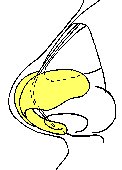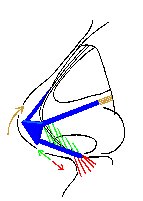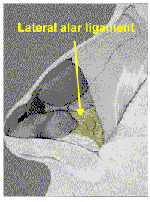
Introduction
Ancient history
Modern history
Traditional operation
Open rhinoplasty
Template rhinoplasty
Alar base reduction
Septal surgery
Implants
Revisions
Cartilage grafts
Bone grafts
Problems
|
Template Rhinoplasty
Paul O'Keeffe developed this operation after
years of dissatisfaction with the traditional rhinoplasty
operation and a study of fresh cadaver nasal anatomy. It is a
closed rhinoplasty so there is no external
scarring. The operation is fully described in a textbook with international release in 2019.
Muscle was found in the columella base that
acts like a tether, pulling the columella
backwards when the columella is made to sit higher on the face by
nasal shortening.
Apart from the muscle in the columella base, which could be
called the superficial depressor septi muscle,
plentiful elastic tissue was found in the mucous
membrane above the columella, which pushes the columella forward.
Thus, there are balancing forces controlling projection
of the nose tip.
There is, in Template Rhinoplasty, a complete
elevation of the skin and soft tissue from the nasal
pyramid that facilitates its redistribution so thickening
of the tissue is hardly ever seen. Thus, accurate pre-op
planning becomes an option.
 |
The template rhinoplasty takes these
three factors (tether effect, columella
projection and alar complex length) into account when planning
the changes to the nose. During the planning the nose tip is
repositioned first and then the rest of the nose is changed to
fit in with the new tip position. |
 |
| Planning is done on clinical photographs and
when a pleasing change is worked out it is duplicated on
life-sized photographs. Usually there will be a shortening of the
lateral alar ligament and the exact amount of
shortening to produce the desired changes can be
measured on the life-size photograph. A template
is made by tracing on polycarbonate sheet over the life-size
profile photograph. The template is cut out and is used during
the operation to guide the surgical reduction of the nose. |
   
|
|
Point to photos for
descriptions
|
| The template is used post-operatively to
check on the changes to the profile, that is,
the overall projection of the tip, the
tilt of the tip and the reduction of the
bridge line. Experience has shown that the nose
tip is now more stable in position and drooping is rarely seen
for primary rhinoplasty. |
| A further benefit for patients having this type of
rhinoplasty has been noted: the airway is
usually clearer. This is due to increased
tension in the lateral wall of the nose, at the lateral alar
ligament.
Slackness of the lateral alar ligament can be
assessed by pulling the cheeks laterally, tensioning the sides of
the nose. If this makes the airway is clearer it is likely that
the template rhinoplasty will improve the function of the
nose.
|
 |
A disadvantage of template rhinoplasty is the
longer time required for planning and for doing the operation and
the corresponding greater expense.
There is a more detailed description of this
operation in the Template Rhinoplasty section of this site.
Back to Top
|




